The City of the Crown Princes (Şehzadeler Şehri) Population: 90,000
Favourite son: Strabo (geographer and historian)
Festival: 12 June start of festivities to commemorate the 1919 Amasya Congress
Amasya surely has to be one of the most visually stunning places in Turkey. This small northern Anatolian town with lovely old wooden houses hanging over the waters of the Yeşilırmak river and ancient Pontic tombs punctuating the rockface of Haşena Dağı (272m) behind it is home to as fine of collection of early Ottoman monuments as you’ll find this far east, a reminder of the days when it was one of a trio of towns (with Trabzon and Manisa) that were used for preparing Ottoman princes for government.
Conservationists have had more success in preserving the cityscape here than in much of the country, making this a great place to relax and unwind for a few days. Unfortunately the Turks themselves have well and truly discovered Amasya which means that over the summer holiday period its narrow streets heave with visitors.
Must-see sites: Pontic tombs, Hatuniye Mahallesi, II Beyazıd Cami, Archaeological Museum, Bimarhane Medical Museum, Büÿük Ağa Medresesi, Saraydüzü Kışla
Around town: Hatuniye Mahallesi and the Pontic Tombs
The best place to start exploring is the Hukumet Köprüsü (bridge) in front of the Ottoman clocktower in the town centre. Originally built in 1865 this was pulled down in 1940 only to be rebuilt in 2002. From here you can look along the river at the silhouette of the lovely old Ottoman houses (called the Yalıboyu Evleri), most of them newly restored and turned into hotels.
Next, stroll along the north bank of the river through the Hatuniye Mahallesi (neighbourhood). This is the throbbing heart of Amasya’s tourism industry, with most of the hotels, restaurants, live music venues and souvenir stands. Here you will find the Hazeranlar Konağı, a fine house dating back to 1865 that is open to the public (closed Mondays). It will give you a good idea of what comfortable middle-class life in Amasya would have been like in the 19th century. The basement hosts a changing programme of exhibitions.
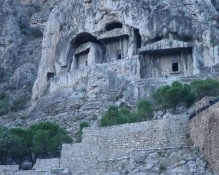 Nearby steps lead up to Amasya’s main attraction: the arched niches known as the Tombs of the Pontic Kings, some of them dating back to the fourth century BC. None of the tombs contains any remains but they make a very picturesque sight, especially floodlit at night. Here, too, are the slight remains of the so-called Palace of the Maidens. The paths to the tombs are treacherously slippery so wear shoes with a good grip. At the time of writing (August 2012) they were also disfigured with tagging.
Nearby steps lead up to Amasya’s main attraction: the arched niches known as the Tombs of the Pontic Kings, some of them dating back to the fourth century BC. None of the tombs contains any remains but they make a very picturesque sight, especially floodlit at night. Here, too, are the slight remains of the so-called Palace of the Maidens. The paths to the tombs are treacherously slippery so wear shoes with a good grip. At the time of writing (August 2012) they were also disfigured with tagging.
A steep path climbs eventually to Haşena Kalesi (castle) on the summit of the rock – there’s easier access from the main road to Samsun.
Just beside the bridge facing the entrance to the tombs one of the restored houses now contains the Şehzadeler Müzesi, a small exhibition of waxwork models of the Ottoman princes (şehzadeler) – amongst them Mehmed the Conqueror – who spent some of their youth playing at statecraft in Amasya. It’s mildly interesting although probably not worth the entrance fee for most foreign visitors.
Time on your hands: Gök Medrese, Halifet Gazi Kümbet, Beyazıd Paşa Cami, Çilehane Cami, Şehzadeler Müzesi, Hazeranlar Konağı
Around town: the south side of the river
A walk along the south side of the river will take you past a succession of magnificent Selçuk and early Ottoman structures starting, at the west end, with the 13th-century Gök Medrese Cami (Mosque of the Sky Blue Seminary), so named for the tiles that once covered the roof of the adjoining tomb of Emir Tortuntay, a governor of Amasya. The huge eyvan (arched recess) in front of the entrance is very unusual.
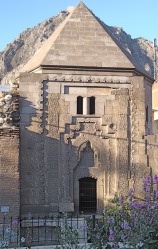 Nearby, and set back from the main road so it’s easy to miss, is the elaborately carved Danişmend-era Halifet Gazi Kümbet (tomb) dating back to 1146. Also nearby is the attractive Yörgüç Paşa Cami dating back to 1428 and built for a vizier of Sultan Murad II.
Nearby, and set back from the main road so it’s easy to miss, is the elaborately carved Danişmend-era Halifet Gazi Kümbet (tomb) dating back to 1146. Also nearby is the attractive Yörgüç Paşa Cami dating back to 1428 and built for a vizier of Sultan Murad II.
Just down the road is Amasya Museum (closed Mondays) which contains a fairly predictable collection of archaeological and ethnographic items but also some impressive mosaics found during roadworks in the late 2010s. In its grounds, a Selçuk tomb used to serve as the last resting place for a collection of gruesome mummies dating back to the 13th-century İlkhanid period and found beneath the Burmalı Minare Cami. They are now housed inside the museum.
A little further east the huge and impressive II.Beyazıt Cami (Mosque of Sultan Beyazıt II) with its two differently decorated minarets stands in a garden framed by sweet-smelling box hedges. Dating back to 1486, it forms the centrepiece of a complex which still retains a medrese (seminary), kütüphane (library), imaret (soup kitchen) and tabhane (dervish lodge). The imaret houses a miniature model of Amasya which may entertain children. Adults will probably prefer the folk-art drawings on the inner ceiling of the şadırvan (ablutions fountain).
As you keep walking east towards the town centre you will pass the Taş Han (Stone Han), a late (1758) caravanserai that has been restored, with, behind it, the Selçuk and later Burmalı Minare Cami (1247), a mosque with, as its name suggests, spiral carvings on its minaret. Closer to the river the restored Vakıf Bedesten Kapalı Çarşı still serves as a covered market.
Eventually you will arrive in the large square in front of the Gümüşlü Cami (Silver Mosque) that provides the setting for annual celebrations of the Amasya Congress that occurred before the start of the Turkish War of Independence on 22 June 1919. Despite its 14th-century origins, the current mosque is mainly a late Ottoman structure.
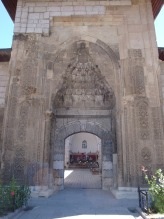 If you continue walking east along the south bank of the river you will come next to the restored Darüşşifa (Bimarhane), an imposing building that dates back to 1309 when it was built for the wife of the Ilkhanid Sultan Olcaytu in a style that is so close to Selçuk as to make little difference. It is now the Şerefeddin Sabuncuoğlu Museum of Medicine and Surgery with information on the use of music in healing, particularly fitting since this is thought to be one the first places in Turkey where music was used to treat mental disorders. Look closely at the columns of the porticoes on each side and you’ll realise that they were reused from earlier Roman or Byzantine buildings.
If you continue walking east along the south bank of the river you will come next to the restored Darüşşifa (Bimarhane), an imposing building that dates back to 1309 when it was built for the wife of the Ilkhanid Sultan Olcaytu in a style that is so close to Selçuk as to make little difference. It is now the Şerefeddin Sabuncuoğlu Museum of Medicine and Surgery with information on the use of music in healing, particularly fitting since this is thought to be one the first places in Turkey where music was used to treat mental disorders. Look closely at the columns of the porticoes on each side and you’ll realise that they were reused from earlier Roman or Byzantine buildings.
A little further east is the Mustafa Bey Hamamı, a Turkish bath that is still in business today. It was once part of the complex attached to the Mehmet Pasa Cami, just across the road, which was built in 1486 for Lala Mehmet Paşa, a grand vizier to Sultan Beyazıt II.
Soon after this you will come to the fine double-domed, porticoed Beyazıdpaşa Cami, dating back to 1419. Uphill behind it you will eventually find the Azeriler (Şırvanlı) Cami, built in 1893 using money collected from Caucasian immigrants. It has a particularly pretty, peaceful garden.
Even further uphill is the Çilehane Cami, built in 1413 and originally serving as a dervish lodge, hence its unusual interior layout, with students’ rooms complete with fireplaces running off a corridor and the small prayer hall accessed up a few steps. Its founder, Yakup Paşa, is buried in a tomb just outside. 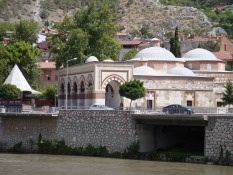
Cross over the Künç Köprüsü facing the Beyazıdpaşa Cami to discover one of Amasya’s most striking monuments, the octagonal Büyük Ağa Medresesi, designed in this unusual, inward-looking form in 1488 for Hüseyin Ağa, the chief white eunuch in Sultan Beyazıt II’s entourage. Still in use as a Koranic school today, it’s not open to the public.
In front of it stands an imposing building, the Saraydüzü Kışla (Barracks), rebuilt on this waterside site in 2007 after the original repeatedly slipped down the opposite hillside. It houses the Milli Mücadele Müzesi (National Struggle Museum), telling the story of Amasya’s role in the War of Independence.
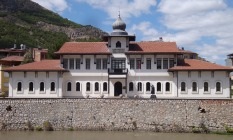 One last sight is a little apart from all the others. The Aynalı Mağara (Mirror Cave) is an isolated Pontic tomb with a Greek inscription running along its facade and fading frescoes that suggest it was later pressed into service as a Byzantine church. It’s roughly 4km from the north side of the Künç Köprüsü.
One last sight is a little apart from all the others. The Aynalı Mağara (Mirror Cave) is an isolated Pontic tomb with a Greek inscription running along its facade and fading frescoes that suggest it was later pressed into service as a Byzantine church. It’s roughly 4km from the north side of the Künç Köprüsü.
Sleeping
Most of Amasya’s best hotels are in the Hatuniye Mahallesi but while this is historically interesting and aesthetically beautiful it can be noisy in summer and mosquitoes can take the edge off a stay in the waterside properties.
Apple Palace Hotel
If you’re after conventional four-star comforts then this hotel high up on the hillside 5km south of town could fit the bill. Don’t expect architectural elegance or any hint at Amasya’s heritage in the design. Do expect minibars, flash TVs and a swimming pool. The views are magnificent.
Tel: 0358-219 0019, www. applegrup.com
Emin Efendi Konakları
Expanding collection of houses on the river and inland side of Hatuniye Mahallesi.
Tel: 0358-212 6622
Eylül Buğusu
Small but perfectly formed, this pension (its name means September Mist) on the north bank of the river has just a handful of individually decorated, characterful rooms, each with its own slightly less jazzy bathroom. There’s a great courtyard where locals gather to drink tea, a restaurant and a bar in the basement.
Tel: 0358-212 1405
Ezgi Konakları
Diminutive waterside pension in a 160-year-old building with a cosy concealed courtyard. You’ll get more luxurious fittings elsewhere but not perhaps so much atmosphere.
Tel: 0358-218 7300, www.ezgikonaklari.com
Grand Pasha Hotel
One of the more beautiful houses near the Hürriyet Köprüsü and with a popular restaurant that features live music at night.
Tel: 0358-212 4158
Lale Han Hotel
Away from most of the other hotels beside the river near the rebuilt Saraydüzü Kışla, the Lale Han is new and features some rather jazzy/OTT decor in the lobby. But if you want to be sure of a quiet night this might be a more reliable option than the Hatuniye Mahallesi places.
Tel: 0358-212 7777, www.lalehotel.com
Transport info
There is no airport at Amasya but it is only five hours by bus from Ankara.
The otogar is east of town but in August 2012 there were plans to relocate it to a more distant site. There are regular onward buses to Tokat although it’s sometimes quicker to take a Turhal dolmuş and change; to get to Safranbolu you normally need to change bus at Gerede.
Half-hourly minibuses to Merzifon leave from beside the Büyükağa Medresesi.
Train services run to Sivas and Samsun.
Day trip destinations
Saraycık


